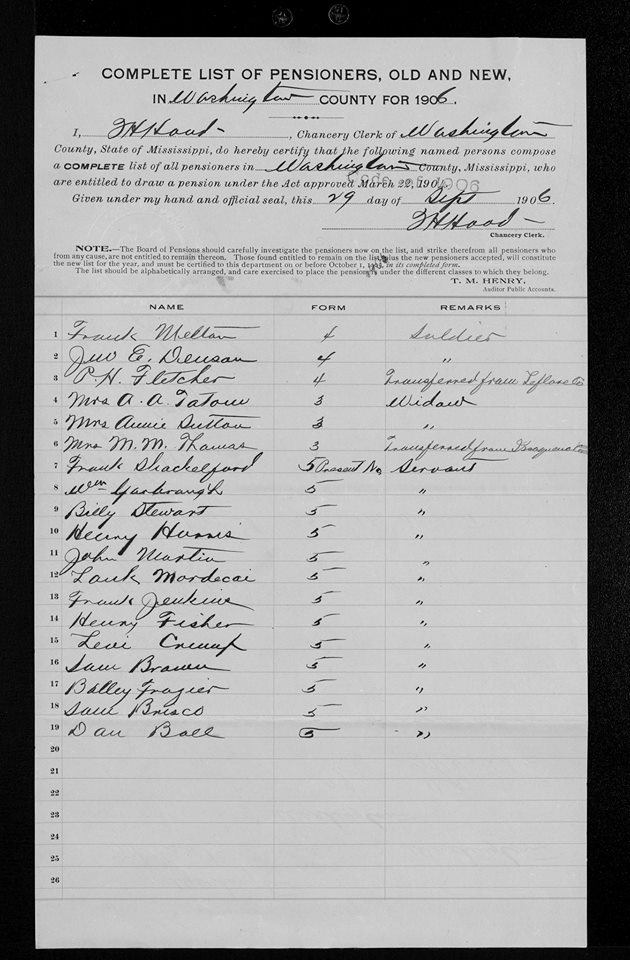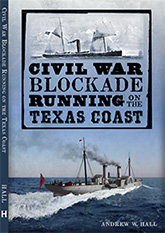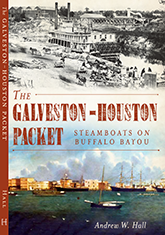A Little Knowledge. . . .
Over at Mid-South Flaggers, the admin there has been doing a little independent research on Confederate pensions from Washington County, Mississippi, and is disturbed by what he’s found — or rather, what he’s not found:

![]()
He’s right; the word “slave” does not appear on the documents he’s looking at. Instead, they’re referred to as “servants,” and there are thirteen of them listed on the page he posted to illustrate his findings:
![]()

![]()
True, an example servant’s pension application he posted requires applicants to identify “the name of the party whom you served,” and the military unit “in which your owner served,” but it doesn’t use the word slave, and that’s what matters, right? 
Yes, Mid-South Flagger, you’ve been lied to. Just not by who you think.
______________






Andy-Look at the original Constitution. There are several provisions that clearly deal with slavery. No one doubted that the provisions dealt with slavery. The debates are quite explicit that these provisions specifically dealt with slavery which was a repeated and very contentious issue during the Constitutional Convention. Yet, the word slave or slavery appears NOWHERE in the Constitution. This was not an accident. On August 25, 1787, efforts to explicitly refer to slaves/slavery were unsuccessful with James Madison stating that he “thought it wrong to admit in the Constitution the idea that there could be property in men.”
Believe me, I understand.
I know you understand. It’s just so intensely frustrating that people can’t or won’t comprehend the most basic realities of dealing with and researching about slavery. It’s not even a matter of discussing morality. It’s simply understanding the terms and idioms that whites themselves used in discussing slaves and slavery during the antebellum period.
You are doing the Lord’s work, Andy. “Know the truth, and the truth shall make you free.”
I’m not doing anything remotely as profound as that, but thanks. The whole issue of Confederate pensions — what they say and what they don’t — is a complex one, and many of the people citing them as evidence of this or that don’t seem to have the foggiest idea what they actually say.
Yes, I know that from personal experience involving my son-in-law whose g3grandfather’s service in the 6th Alabama was erroneously cited as evidence of a “black Confederate.” His pension application revealed he was a slave cook, who had been loaned to the regiment by his owner who was serving in another Alabama regiment. He is buried in Tennessee and a local SCV camp in recent years put up misleading gravestones for him and several others in this African American cemetery that implied they were uniformed soldiers fighting for the CSA.
“He is buried in Tennessee and a local SCV camp in recent years put up misleading gravestones for him and several others in this African American cemetery that implied they were uniformed soldiers fighting for the CSA.”
That has happened numerous times. Then they turn around an cite the gravestone they themselves created as independent evidence of ZOMG Black Confederate!
Do you believe this is be intentional dishonesty or just complete stupidity, or a combination of both?
I believe it varies. In the majority of cases it’s a combination of (1) a lack of any real understanding of the antebellum United States or the fundamental nature of slavery, and (2) little ability to do much in the way of primary source research, or to understand those documents in the context of other sources. Very often what you get is something like this case, where “Mid South Flagger” is so annoyed by the references to these men having been enslaved that he goes looking for the word “slave” and, not finding it, has thus “proven” that he’s been “lied to.” It’s all very superficial.
Binding all this together is, I believe, a real psychological (and largely subconscious) need for “black Confederates” to be real, because then that removes the ugly specter of chattel bondage from the discussion. If you look at these cases for a while, you realize that they’re not much interested in researching of telling these mens’ individual stories, as they are in chalking up another “black Confederate” and moving on to the next one. Hell, there’s a whole fake cemetery for them in Pulaski, Tennessee that they dedicated a few years ago.
There are also people out there who absolutely know better, but nonetheless promote the idea of “black Confederates” for other reasons, perhaps because the idea has become part of modern Confederate heritage orthodoxy at this point.
Ugh — just realized Coleman is one of the group from Pulaski. Did any of his other descendants participate in that?
The Pulaski group is (IMO) one of the more egregious examples of mangling real mens’ stories to fit a set agenda, and it’s a real mess. Unlike other cases, the VA actually refused to provide stones for that, so the local UDC and SCV did it through private donors.
If it seems like they went a little overboard, it’s worth understanding that the Confederate heritage folks in Pulaski really do want their town to be known for something else when it comes the CW, slavery and race.
As far as I know Coleman is the only descendant of my son-in-law’s who is buried there in Pulaski. You say “fake cemetery.” Do you mean all the fake tombstones, or are folks not really buried there? I’m a little confused. I only know about this because I’ve tried to do a little research on his ancestry. As I mentioned to you in an email there’s a slight possibility that he might be related to Milton Holland, who raised Company C of what became the 5th United States Colored Infantry here in Athens, Ohio, at the fairgrounds. We recently put up an historical marker about this, and also have a bill introduced by our local congressman to posthumously restore the battlefield commission Holland received at Chaffin’s Farm (New Market Heights) from General Benjamin Butler. At this point all I know is that his Holland descendants were in Tennessee about the same time as his father’s family. His father was Bird and his mother one of his slaves. She apparently also was the mother of two other of Bird’s sons.
First, let me explain my use of the term “fake cemetery,” because it is a harsh term. I did not realize that the Coleman you mentioned was part of that group, and did not mean to offend.
However, there is reason why I have referred to that site a “fake” or “faux” cemetery. As far as I can tell, only four of the 19 men listed on the stones there are actually interred somewhere at Maplewood, and several have no known gravesite at all. The local SCV and UDC obtained a large plot in Maplewood Cemetery, that (according to some accounts) had actually been used as a burying ground, but now has no marked graves. The applied the VA for government-issued headstones, which were denied because the VA felt the men in question had not been soldiers, so they fund-raised and had stones made that closely resembled those issued by the VA. They put them out and dedicated at a ceremony in 2009, pictures here:
I have referred to it as a “fake” cemetery because I believe, frankly, that’s what it is — something intentionally made to look like a cemetery, that’s not. Setting aside the open misrepresentation of these mens’ stories, it’s purposely misleading; there are innumerable other ways to recognize or highlight there stories without setting up a make-believe graveyard, particularly if it’s set over over, real-but-unmarked graves.